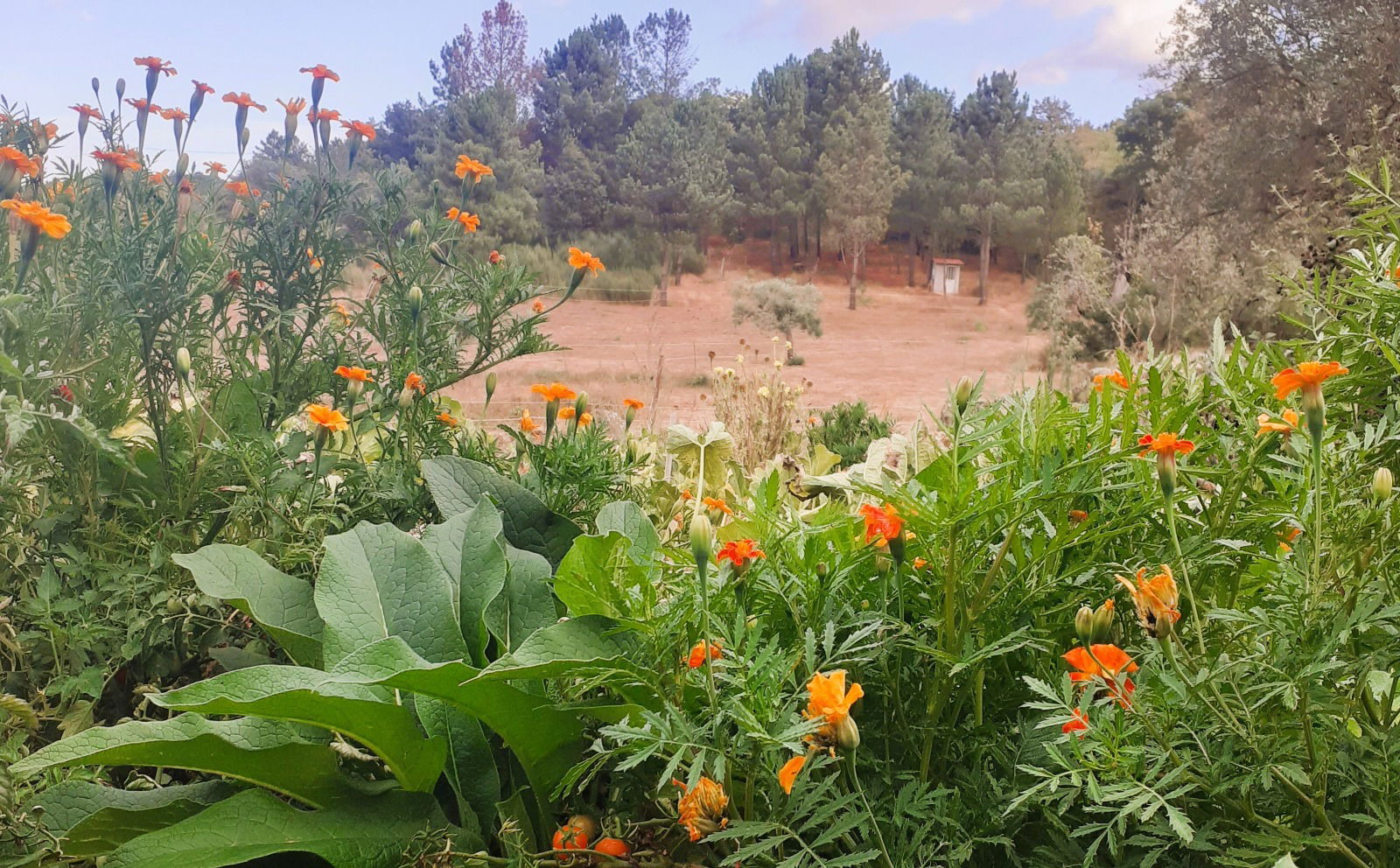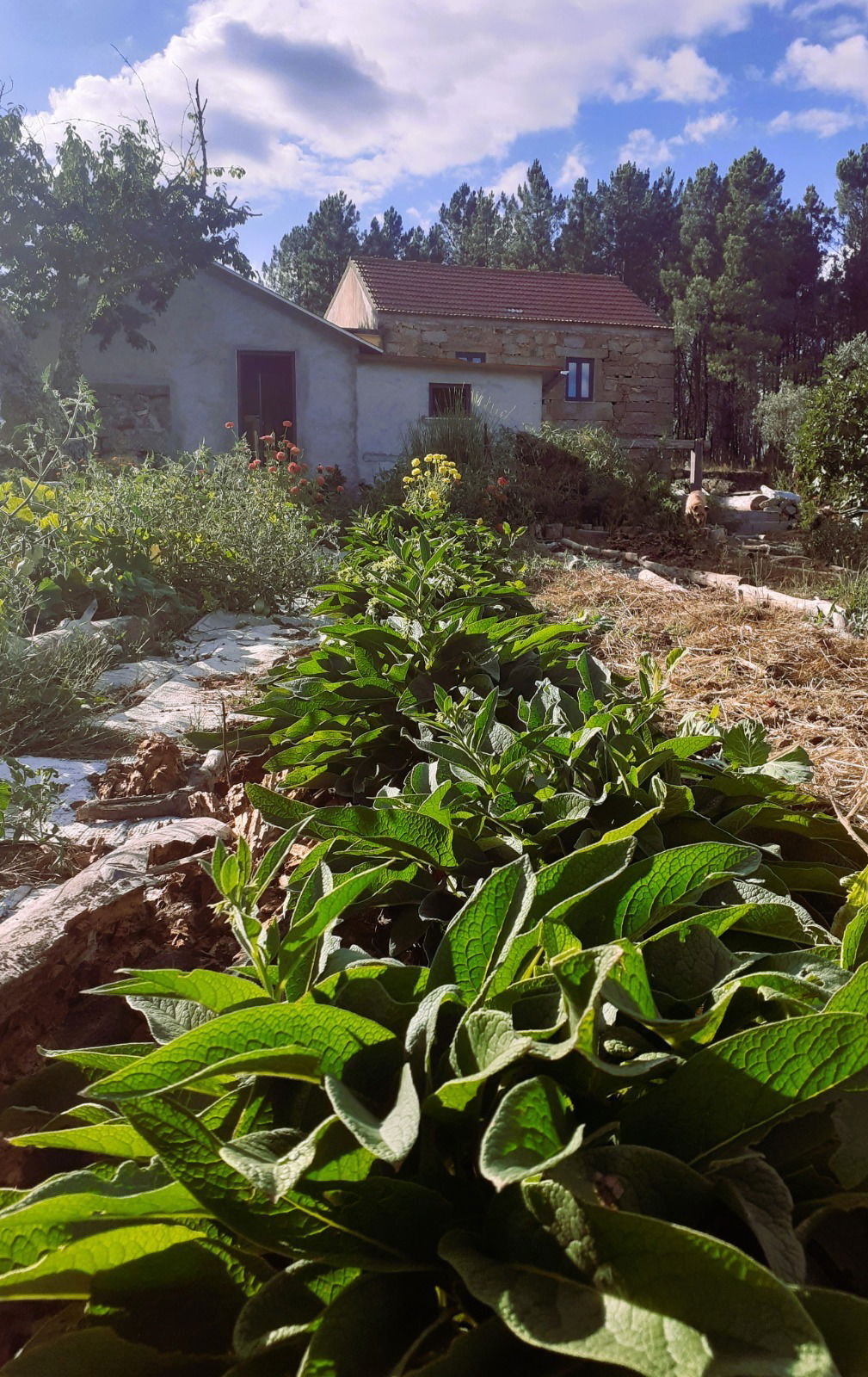COMFREY (Symphytum)
We grow and sell the Bocking 14 variety (Symphytum x uplandicum), an amazing plant with many uses. Order root cuttings or plants here!
Comfrey in Permaculture, Composting, and Healing
Comfrey is one of those must have plants in permaculture design. It is a dynamic accumulator by the way its roots break up compacted, hard ground, reaching deep into the soil to draw up nutrients normally inaccessible at the surface. Its nutrient-rich leaves make fantastic mulch, activate compost, and offer shade at ground level.Its abundant purple or white flowers are a haven for bees, drawing masses of natures pollinators into your garden throughout its long flowering season.
How to Grow Comfrey
Comfrey is very easy to grow from rootstock, and can be grown directly in the soil or in pots. Simply lift a comfrey plant in the autumn, and plant sections of root wherever needed (you can plant comfrey from root any time there is no frost, but autumn is generally better for lifting any rooted plant because that is the time of year the roots are strongest).
Several small plants can be easily separated by lifting one root system. The deep roots of comfrey that are left behind, ensure that come spring a new comfrey plant will grow in the place of the old one. So you don’t even need to replant in the original location. Comfrey needs a lot of water, not only whilst establishing, but throughout its life, and thought should be given to this when planting. It thrives well in boggy areas and along the edge of streams. When planting in your garden, it is good to plant comfrey in an area that will need regular watering anyway.
Comfrey as a Companion Plant
Comfrey makes an amazing companion plant due to its ability to draw up deep nutrients to the surface. It is always regenerating new leaves which then die and naturally function as a mulch, dropping the nutrients back into the surface soil and making them available to surrounding plants. In hot climates, the large leaves also give shade to sensitive root systems, whilst being relatively low lying, therefore enabling the growth of neighbouring plants above ground. Do consider, when using comfrey as a companion plant, that its deep tuberous roots are hard to remove from a patch once established.

Comfrey works exceedingly well around young trees where it acts as a continuous mulch and soil rejuvenator. In such a place it will give you an ongoing and abundant crop of leaves to fertilise your garden.

Comfrey Mulch
The nutrient rich foliage makes comfrey an incredible mulch plant for your garden. Simply cut the fresh leaves and lay them around existing plants. This gives good ground coverage and a nutrient sink for your plants at the same time.

Comfrey Liquid Fertiliser
Comfrey is rich in Nitrogen, Phosphorous, Potassium, Protein, and many other vitamins and minerals, and so makes an excellent liquid fertiliser.
The recipe is simple: Fill a bucket or other such container with comfrey leaves, then fill with water until the leaves are just submerged beneath the surface. Cover the bucket to avoid animal interactions. The mixture needs to be stirred every day until smelly. The time this will take varies depending on the weather, it can be a few days in high summer, or a few weeks in winter. Once it’s good and stinky, it’s ready to use and should be strained. (Add the strained leaves to your compost as a fantastic activator).
For young plants this mixture needs to be diluted to about a 20:1 mix, increasing in strength as the plant matures to around 5:1.· The mixture should be applied to the soil around your plants once a week, avoiding getting the mixture on any edible fruits or foliage.
Comfrey, the Great Compost Activator
Comfrey makes an amazing activator when making compost, especially when dealing with a lot of brown compost such as grass cuttings that are usually slow to decompose. Simply layer your compost with plenty of fresh-cut comfrey leaves, and you will notice a marked decrease in the composting time. In fact, used regularly, it can easily decrease composting time by around a quarter, whilst adding a lot of beneficial nutrients to your finished compost.
What the Bocking?
You may have heard of Bocking 14 often being mentioned in connection with comfrey. Bocking is in fact the name of a small village near Braintree in England, which in the 1950s was home to a comfrey research program developed by Lawrence D Hills. Hills studied 21 different comfrey strains and they were all labelled numerically after the village of Bocking where the research took place. Bocking 14 was found to have the highest nutrient content, and had the bonus of being a non-seeding variety, preventing it from spreading throughout the garden.
The Legendary Healing Power of Comfrey
The colloquial name for comfrey is Knitbone, and this attests to its legendary ability to heal bones and wounds. In fact, it is known to heal all the tissues of the body, and has been used to great effect for millennia in the healing of problems as diverse as bronchitis and haemorrhoids. It is high in a substance called allantoin which stimulates cell proliferation, rich in muciligens that soothe the affected area, and high in tannins which act as an astringent. The mashed-up root can be applied as a poultice for most external wounds, but respect should be made for the increased rapidity of healing, and should not be applied to deep or dirty wounds as the skin could heal over too fast trapping infection inside.
Internally it has been traditionally used to treat stomach ulcers, hiatus hernias, and respiratory problems. It is said to tone the urinary system, relieve cystitis, relax spasms, and clear irritation. You may have heard some bad press about ingesting comfrey, so here are the facts: Internally, comfrey products in some countries have been banned. This is due to the controversial LD50 (Lethal Dose 50) test being performed in 1968 on laboratory mice. In comfrey, as in all members of the borage family, there are trace amounts of a substance called pyrrolizidine alkaloids, which in high doses is known to be harmful. This substance was extracted and injected into mice at an equivalent of 30% of their food, every day, until 50% of them died. The equivalent intake in humans would be over 5,000 leaves! It is therefore personal choice whether you use comfrey's amazing healing powers internally on yourself. It is also advisable not to offer comfrey to another without them making their own informed choice on the matter.
In Conclusion
Comfrey is an enriching plant to grow in your permaculture garden, and our ancestors have known this for thousands of years. In fact, humans have been growing comfrey in their gardens, as both a food crop and medicine, since early man first started to propagate plants for his own use.
This is a link to a very informative site for further reading and in-depth knowledge by a true comfrey connoisseur named Paul Alfrey: Comfrey: Its History, Uses & Benefits

Permaculture
Here at Quinta das Faíscas - Permaculture and Ponies we are always happy to answer questions and offer advice, so please feel free to contact us. We also have the nutrient rich Bocking 14 for sale: COMFREY PLANTS - Quinta das Faíscas
This article was written by Louise Eves, Herbal Compendium Dpl., Holistic Therapist Dpl.
Photo credit: Louise Eves at Quinta das Faíscas
permacultureandponies@gmail.com
